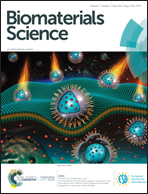Influence of the physicochemical characteristics of diatom frustules on hemorrhage control†
Abstract
Uncontrollable hemorrhage is the main cause of death in military and civilian accidents. It is therefore necessary and an urgent requirement to develop a safe and efficient hemostatic material. In this study, the hemostatic performance of frustules of three centric diatom species (Thalassiosira weissflogii, Thalassiosira sp., and Cyclotella cryptica) with similar shapes and different sizes was investigated. The complicated structure of T. weissflogii, leading to its highest BET surface area (169.5 m2 g−1) and liquid absorption (51.4 ± 1.6 times the weight of liquid), exhibited the shortest hemostasis time (158 ± 8.19 s) in in vitro blood coagulation. Thalassiosira sp. had a shorter hemostasis time (167.33 ± 14.74 s) than that of QuikClot® and C. cryptica, indicating that diatom size also played an important role in hemostasis due to the interface reaction between the material and plasma protein. The in vivo hemostasis results further confirmed this conclusion. Diatom frustules also exhibited favorable blood compatibility (<5%), and no significant cell toxicity could be observed from the three frustules. Our results suggest that the coagulation effect of frustules is strengthened upon a decrease in the size and increase in the liquid absorbability. This report provides valuable information for the medical application of diatom frustules in the field of hemorrhage control.



 Please wait while we load your content...
Please wait while we load your content...